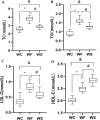Proteomics study on the effect of silybin on cardiomyopathy in obese mice
- PMID: 33785854
- PMCID: PMC8009917
- DOI: 10.1038/s41598-021-86717-x
Proteomics study on the effect of silybin on cardiomyopathy in obese mice
Abstract
Due to the increase in the number of obese individuals, the incidence of obesity-related complications such as cardiovascular disease and type 2 diabetes is higher. The aim of the present study was to explore the effects of silybin on protein expression in obese mice. Firstly, serum was collected, and it was used to detect serum lipids and other serological indicators. Secondly, total protein from epididymal adipose tissue was extracted for differential expression analysis by quantitative tandem mass tag (TMT) combined with liquid chromatography-tandem mass spectrometry (LC-MS/MS), followed by bioinformatics and protein-protein interaction (PPI) network analyses of these proteins. Lastly, real-time polymerase chain reaction (RT-PCR) and parallel reaction monitoring (PRM) were used to further validate the expression of identified differentially expressed proteins (DEPs) at the mRNA and protein level, respectively. The results revealed that silybin could improve abnormal lipid metabolism caused by the high fat diet in obese mice. A total of 341, 538 and 243 DEPs were found in the high fat/control (WF/WC), silybin/high fat (WS/WF) and WS/WC groups, respectively. These DEPs mainly participated in lipid metabolism and energy metabolism. Notably, tropomyosin 1 (TPM1), myosin light chain 2 (MYL2), myosin heavy chain 11 (MYH11) and other DEPs were involved in hypertrophic cardiomyopathy, dilated cardiomyopathy and other pathways. Silybin could protect cardiac function by inducing the protein expression of TPM1, MYL2 and MYH11 in the adipose tissue of obese mice.
Conflict of interest statement
The authors declare no competing interests.
Figures










Similar articles
-
Quantitative proteomics analysis based on tandem mass tag labeling coupled with labeling coupled with liquid chromatography-tandem mass spectrometry discovers the effect of silibinin on non-alcoholic fatty liver disease in mice.Bioengineered. 2022 Mar;13(3):6750-6766. doi: 10.1080/21655979.2022.2045837. Bioengineered. 2022. PMID: 35246007 Free PMC article.
-
The Effect of Silibinin on Protein Expression Profile in White Adipose Tissue of Obese Mice.Front Pharmacol. 2020 Feb 28;11:55. doi: 10.3389/fphar.2020.00055. eCollection 2020. Front Pharmacol. 2020. PMID: 32184719 Free PMC article.
-
Proteomic analysis reveals semaglutide impacts lipogenic protein expression in epididymal adipose tissue of obese mice.Front Endocrinol (Lausanne). 2023 Mar 21;14:1095432. doi: 10.3389/fendo.2023.1095432. eCollection 2023. Front Endocrinol (Lausanne). 2023. PMID: 37025414 Free PMC article.
-
Silybin ameliorates hepatic lipid accumulation and modulates global metabolism in an NAFLD mouse model.Biomed Pharmacother. 2020 Mar;123:109721. doi: 10.1016/j.biopha.2019.109721. Epub 2019 Dec 20. Biomed Pharmacother. 2020. PMID: 31865143
-
Effects of Semaglutide on Cardiac Protein Expression and Cardiac Function of Obese Mice.J Inflamm Res. 2022 Nov 24;15:6409-6425. doi: 10.2147/JIR.S391859. eCollection 2022. J Inflamm Res. 2022. PMID: 36452054 Free PMC article.
Cited by
-
Single-cell transcriptomic analysis reveals transcript enrichment in oxidative phosphorylation, fluid sheer stress, and inflammatory pathways in obesity-related glomerulopathy.Genes Dis. 2023 Sep 14;11(4):101101. doi: 10.1016/j.gendis.2023.101101. eCollection 2024 Jul. Genes Dis. 2023. PMID: 38560497 Free PMC article.
-
CCND1 Overexpression in Idiopathic Dilated Cardiomyopathy: A Promising Biomarker?Genes (Basel). 2023 Jun 10;14(6):1243. doi: 10.3390/genes14061243. Genes (Basel). 2023. PMID: 37372424 Free PMC article.
-
Novel Time-dependent Multi-omics Integration in Sepsis-associated Liver Dysfunction.Genomics Proteomics Bioinformatics. 2023 Dec;21(6):1101-1116. doi: 10.1016/j.gpb.2023.04.002. Epub 2023 Apr 20. Genomics Proteomics Bioinformatics. 2023. PMID: 37084954 Free PMC article.
-
Flavonoids: Potential therapeutic agents for cardiovascular disease.Heliyon. 2024 Jun 6;10(12):e32563. doi: 10.1016/j.heliyon.2024.e32563. eCollection 2024 Jun 30. Heliyon. 2024. PMID: 38975137 Free PMC article. Review.
-
A Comprehensive Review of the Cardiovascular Protective Properties of Silibinin/Silymarin: A New Kid on the Block.Pharmaceuticals (Basel). 2022 Apr 27;15(5):538. doi: 10.3390/ph15050538. Pharmaceuticals (Basel). 2022. PMID: 35631363 Free PMC article. Review.
References
-
- Poirier P, et al. Obesity and cardiovascular disease: pathophysiology, evaluation, and effect of weight loss: an update of the 1997 American Heart Association Scientific Statement on Obesity and Heart Disease from the Obesity Committee of the Council on Nutrition, Physical Activity, and Metabolism. Circulation. 2006;113:898–918. doi: 10.1161/circulationaha.106.171016. - DOI - PubMed
-
- Kazuhiko, N. & Kinya, O. Inflammation and metabolic cardiomyopathy. Cardiovasc. Res.4 (2017). - PubMed
Publication types
MeSH terms
Substances
LinkOut - more resources
Full Text Sources
Other Literature Sources
Medical
Miscellaneous

